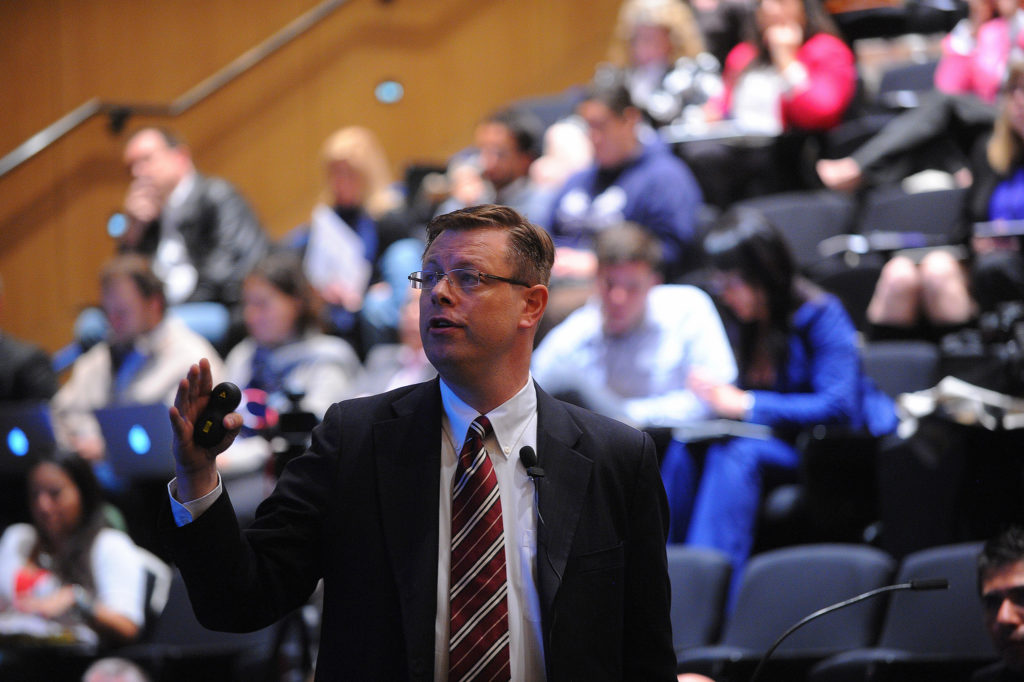May 28, 2013 | Business Models, Distribution, Keynote, Revenue
Clark Gilbert talks about “Innovation, Journalism and Future of journalism” at 14th Annual ISOJ Conference

Guests at the 14th annual International Symposium on Online Journalism received a special treat to kick off the conference. Clark Gilbert, President and CEO of the Deseret News Publishing Company and Deseret Digital Media, delivered a keynote speech to a packed house at UT’s Blanton Museum of Art’s auditorium titled, “Innovation, Journalism and the Future of Newspaper” on Friday morning.
Rod Hart, dean of the College of Communication at UT, introduced Gilbert and the prevalent theme of Gilbert’s presentation—disruptive innovation—saying that perhaps “disruption” was the wrong word for the market shift. He said it would be better called “opportunity.” And opportunity is exactly what Gilbert has embraced in the struggling print media marketplace and was able to turn into his advantage.
Gilbert discussed and walked through his strategic model of disruptive innovation, the subject of his latest article from the Harvard Business Review, “Two Routes to Resilience,”which he co-wrote with Matthew Eyring and Richard Foster.
His model is a basic innovative model and not specific to the media industry. The model outlines a strategy for struggling businesses affected by disruption in the marketplace to become more adaptable and sustainable. The strategy calls for businesses to reposition themselves and reinvent their business models. According to Gilbert, this concept is called “dual transformation,” in which two companies pursue two efforts, Transformation A and B simultaneously. Transformation A calls for the repositioning of the core business to adapt to the disturbance in the market. “Transformation B,” which is built around the disruption itself, calls for the business to develop a new feature or service that will become the source of future growth for the organization, Gilbert said.
“Industries faced with disruptive innovations have a 9 percent survival rate,” Gilbert said. “But 100 percent of the 9 percent had set up the disruptive business as a separate division of the parent company – no exceptions.”
In Transformation A, there are two core activities: dramatically lowering the cost in the core to get cost in line with what it takes to thrive, work and survive in a post-disruption world, and reposition your core business around the post-disruption “job-to-be-done.” In Transformation B the content idea is differentiation. Gilbert explained it as investing where you can be “the best in the world.” And Transformation B means “digital only, not digital first.”
Gilbert pointed out that people who had more than 40 percent market share, 100 percent of those firms had the following characteristics: separate physical location, separate profit and loss, separate direct sales, separate content, product, and technology and separate management structure.
Gilbert said having a separate union does not guarantee getting successfully through the disruption. It’s a necessary, but not sufficient condition to the innovation required. The key is to establish “capabilities exchange.” Gilbert defined this as the legacy business and the disruptive business working together without interfering with each other’s operations.
“Part of the problem for the incumbent firm is that they see the world through the model of their existing business and cannot see new unique value contribution that the disruption is playing all across society even though that may be obvious to everyone else,” Gilbert said.
Gilbert went on to describe the lifecycle of disruption. He said during the first phase, both the disruption and incumbent business grow, progress and parallel in the market, but then in phase 2, disruption starts to show up, and disruption and the incumbent business switch behaviors. This phase is characterized by a surge at the end of the phase. In the last phase, there is a rapid decline of the incumbent business, but it is still around.
Gilbert has completely transformed the Deseret News business model, which is one of the fastest growing newspapers, by applying the “dual transformation” approach. Deseret News has experience growth four years in a row, 40 percent each year.
“We are not smarter than other people, we just have the conditions where people are working hard and focused on the green space [legacy business] can actually win,” Gilbert said. “One of the powers of thinking like a disruptive innovator is if you get structured right, you suddenly look really, really smart even if you are just average—that’s kind of the story of my career.”
ISOJ 2013: Clark Gilbert keynote presentation from Knight Center on Vimeo.

